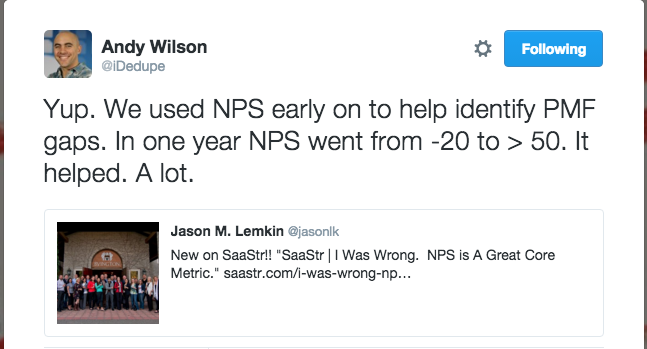I wrote a version of this post way back in 2016. It created a lot of discussions and was more controversial then — that NPS was a great core metric. We’ve all evolved a lot since then. We’ve gotten great at measuring both NRR and GRR. And almost everyone does some sort of regular NPS survey. And most segment it across customer size or other segments.
Back then, I wrote that when I was a SaaS founder, I thought Net Promoter Score (“NPS”) was a somewhat dumb, Big Company metric. There were a bunch of things I didn’t like about it:
- NPS is backward-looking. It doesn’t tell you much about your prospects, the future, or your most recent customers. I wanted to see the future.
- NPS isn’t tied to upsells, churn, or revenue. I didn’t want a metric that was abstracted away from revenue. I cared much, much more about our net negative churn rates per segment (and that the metrics here were always improving), than some abstract NPS score of 42.
- NPS can lead to celebrations of the past … and, even worse, mediocrity in the present. Customers can like an old product that is no longer competitive. (“You’re never getting that copy of ACT! out of my hands!”) NPS doesn’t give any credit for innovation in the future. I saw Big Companies celebrate their NPS scores, even knowing their products were on the way to obsolescence as new entrants were displacing them. That was the exact opposite of the sort of culture I wanted.
These criticisms of NPS are and were all true. But what I also saw was NPS, measured consistently, has big benefits. Now I work with and have invested in 35+ SaaS companies. And many track their NPS monthly, and carefully. And … I love it.
What it turns out I love about NPS:
- >> It keeps a SaaS start-up honest <<. This is my favorite NPS “feature”. Different teams and different executives can have heated debates on your product quality. Engineering thinks it’s good enough. Customer Success thinks everything has to improve – now. Or we’ll lose all our customers. Sales thinks we need 3-4 more features to win deals. Who’s right? NPS is. It’s the voice of the customer. If you have a High NPS score, you’re doing something right here, no matter the feature gaps or other issues. If it’s low — take action, my friends. Stop being so proud of yourself. Your customers aren’t. This is so, so important.
- It does a good job of predicting net negative churn in bigger accounts. If your NPS is high, then at least for larger customers … I pretty much know the upgrades are coming, the net negative churn, the expansion deals, Like clockwork. If your customers love you … you’re gonna sell them more. Even if you aren’t yet. You’ll figure that part out.
- It works, better than I’d expect, on a relative basis. Share your NPS with your CEO friends. Figure out why theirs is higher than yours.
- It builds confidence. Struggling at $1m, $2m, $3m ARR? If your NPS is super high, and going up … well … it’s gonna be OK. It will. Break through to $10m ARR, and life will get better. The cavalry will come.
- A downturn in NPS keeps you honest. If NPS drops, it is often tied to outages, to an overstretched CS team, to a big competitive push by another vendor. When you see it go down, it can shake the team out of a bit of complacency.
- And most importantly, it can be a rallying point for the whole team. The whole team can influence NPS. You can’t always ship that big missing feature, or spend $100m in marketing. But everyone can do something to make customers happier. Challenge the team to via NPS, and watch them rise to the occasion.
I was wrong. Track NPS as a core, monthly metric. Share it with everyone. And, importantly — use it for a cross-functional discussion across Sales, Support, Customer Success, Marketing, Engineering, and Product. It’s the one metric all of them directly impact, and all of them are equally responsible for.
And pair it with driving up NRR, and you’ll see the economic benefits of this hard work.
The power of involving your customers in your roadmap is 🤯. We wanted to make @GainsightHQ easier to manage and deploy (esp for small cos) and created a #CustomerSuccess Ops Council to help guide us. This group took our Admin NetPromoter Score from 31 to 73 in 7 quarters. 🔥 pic.twitter.com/I6HV6y4pmX
— Nick Mehta (@nrmehta) April 4, 2023



